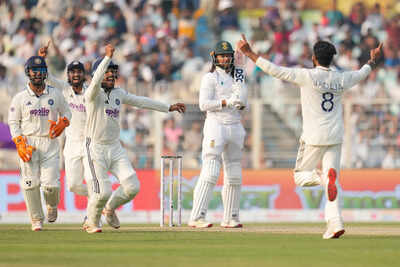Twenty-six wickets in two days leaves the India–South Africa Test on a knife edge | Cricket News

Kolkata: This is turning out to be a bowler’s paradise, thanks to the pitch. By stumps on Saturday, the second day of the first India–South Africa Test at the Eden Gardens here, 26 wickets had fallen in six sessions. Given the wicked variable bounce on offer, batters were often left wondering whether they should come forward or stay back. If one stayed low, the next one rose sharply. This is clearly not the kind of wicket where runs can flow freely and where survival instincts have to be at their best. It showed in the scores. India, chasing South Africa’s first-innings score of 159, managed 189 without skipper Shubman Gill, who had to retire hurt with a neck spasm after facing just three balls. He did not come back for the rest of the day. In a low-scoring match, even a small lead can be the decisive factor, and India’s 30-run advantage gave them the edge. When South Africa came in to bat for the second time, erasing this lead would have been top of their agenda. They did go past it in due time, losing both their openers in the process to India’s spinners. That milestone was hardly noticed as South Africa continued their edgy quest to merely survive, an exercise severely dented by Ravindra Jadeja, with help from the team’s other spinners. Jadeja made the red ball bite as South Africa’s vulnerability to spin was left exposed. Jadeja so far has four scalps in South Africa’s 93/7, with Temba Bavuma holding one end up at 29. The one that got Tristan Stubbs perhaps best exemplifies South African batters’ confusion. Jadeja had one land on middle stump, move out just enough to hit the off stump, and Stubbs was left wondering what had happened. Wily Jadeja had delivered another masterful display. Gill’s retirement proved crucial for India on a wicket that was never easy to bat on. With the South African bowlers getting as much purchase as the Indians did, Gill’s technique would have been paramount. In fact, the sweep he played, which resulted in the neck spasm flaring up, was picture-perfect. With his departure, India were effectively 3/79, having lost Washington Sundar a little earlier. The onus fell on KL Rahul and Rishabh Pant to repair the innings. Although Rahul was cautious, waiting for the right ball, Pant batted like there was no tomorrow. Clearly, Rahul’s scalp had to be earned, while Pant was always in danger of gifting away his wicket. It needed a great catch from Aiden Markram at slips to send back Rahul after a patient, well-grafted 39. Pant could have avoided going for a pull off Corbin Bosch given the circumstances, and only managed to balloon an easy catch to wicketkeeper Kyle Verreynne. His 24-ball 27 would have looked good in a T20 match, but in a Test match, where staying put was the order of the day, Pant’s talent was perhaps wasted. South Africa off-break bowler Simon Harmer troubled India, who are playing with six left-handers, the most. The left-handers were finding him difficult to read. On top of that was the inconsistency in bounce. Ravindra Jadeja and Axar Patel are good on batting wickets, but on surfaces where a lot of unknowns seem to be lurking, they are not the best choices to pull the team out of a rut. Both contributed, but not enough to put India in a commanding position. Now it’s about Bavuma’s grit against India’s relentless spin attack.






